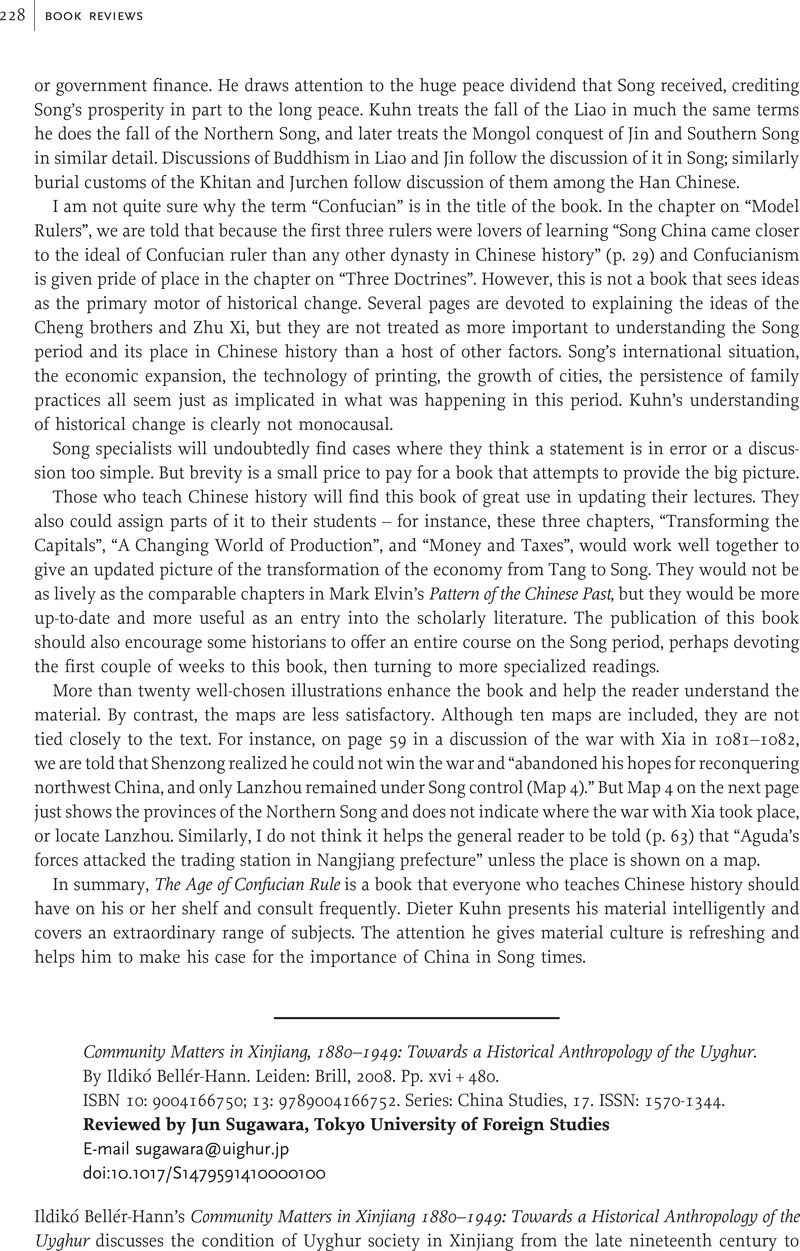No CrossRef data available.
Published online by Cambridge University Press: 15 June 2010

1 Jarring, Gunnar, Culture Clash in Central Asia: Islamic Views on Chinese Theatre (Eastern Turki texts) (Stockholm: Almqvist and Wiksell International, 1990)Google Scholar.
2 About the collection, see Ekström, P. and Ehrensvärd, U., “A Note on the Jarring Collection of Eastern Turki and other Oriental manuscripts in Lund University Library,” in Turcica et Orientalia: Studies in Honor of Gunnar Jarring on his Eightieth Birthday 12 October 1987, ed. Ehrensvärd, U., pp. 187–91 (Istanbul, Stockholm: Swedish Research Institute in Istanbul, 1988)Google Scholar.
3 For example, Shinmen Yasushi criticizes the work of Andrew Forbes, noting that his historical descriptions have not reflected the “several aspects of the relations which exist at multiple levels, with confrontation, dependence, and disregard between Muslim inhabitants and Han rulers.” Shinmen Yasushi 新免康, Review of Andrew D. W. Forbes, Warlords and Muslims in Chinese Central Asia: A Political History of Republican Sinkiang 1911–1949 (書評)アンドリュー・D・W・フォーブズ著『中国領中央アジアの軍閥とムスリム: 民国期新疆 (1911–1949) の政治史』, Tōyō Gakuhō 69:1–2 (1988), pp. 92–99.
4 The major articles on this topic are the following: Chen Guoguang 陈国光, “Guanyu Qingdai Xinjiang Yisilanjiao minfa wenti: qiyue wenshu tantao” 关于清代新疆伊斯兰教民法问题––契约文书探讨 (“On Islamic Civil Law in Xinjiang in the Qing period: A Study of Contractual Documents”), Xiyi yanjiu 92:2 (1992), pp. 34–44; Hori Sunao 堀直, “Kaikyō no shakai keizai bunsho ni tsuite: Chagataigo bunsho no shōkai o chūshin to shite” 回疆の社会経済文書について—チャガタイ語文書の紹介を中心として—(“On Socio-Economic Documents of Hui-jiang: With a Central Focus on the Documents in Chaghatay”), Seinan Ajiashi Kenkyū 54 (2001), pp. 84–107; Sugawara Jun, “Tradition and Adoption: Elements and Composition of Land-related Contractual Documents in Provincial Xinjiang (1884–1955),” in Studies on Xinjiang Historical Sources in 17–20th Centuries, eds. J. A. Millward et al. (Tokyo: The Toyo Bunko, forthcoming); Tömür, Osman, “Möhürnamä wä uningdin parchilar” (“Regarding Documents with Seals with Partial Introductions”), Qumul shähirining tarikh materiyalliri 3-qisim, pp. 88–102 (Qumul, Xinjiang: Qumul Shähärlik Siyasiy Kengäsh, 1994)Google Scholar; Wang Shouli 王守礼 and Li Jinxin 李进新, Xinjiang Weiwuerzu qiyue wenshu ziliao xuanbian 新疆维吾尔族契约文书资料选编 (“Collection of Contractual Documents of Xinjiang Uyghurs”) (Wulumuqi, Xinjiang: Xinjiang Shehui Kexueyuan, 1994).
5 Yong Gui 永貴, Huijiang zhi 回疆志 (rpt. Taipei: Chengwen Chubanshe, 1968); Xinjiang Weiwuer Zizhiqu Bianjizu 新疆维吾尓自治区编辑组 ed., Nanjiang nongcun shehui 南疆农村社会 (“Rural Society in South Xinjiang”) (Wulumuqi: Xinjiang Renmin Chubanshe, 1980); Xinjiang Weiwuer Zizhiqu Congkan Bianjizu 新疆维吾尓自治区丛刊编辑组 ed., Weiwuerzu shehui lishi diaocha 维吾尓族社会历史调查 (“A Socio-historical Survey of the Uyghurs”) (Wulumuqi: Xinjiang Renmin Chubanshe, 1985). For an overview of the Qing sources, see the “Bibliography” in Millward, J. A., Beyond the Pass: Economy, Ethnicity, and Empire in Qing Central Asia, 1759–1864 (Stanford, CA: Stanford University Press, 1998)Google Scholar.